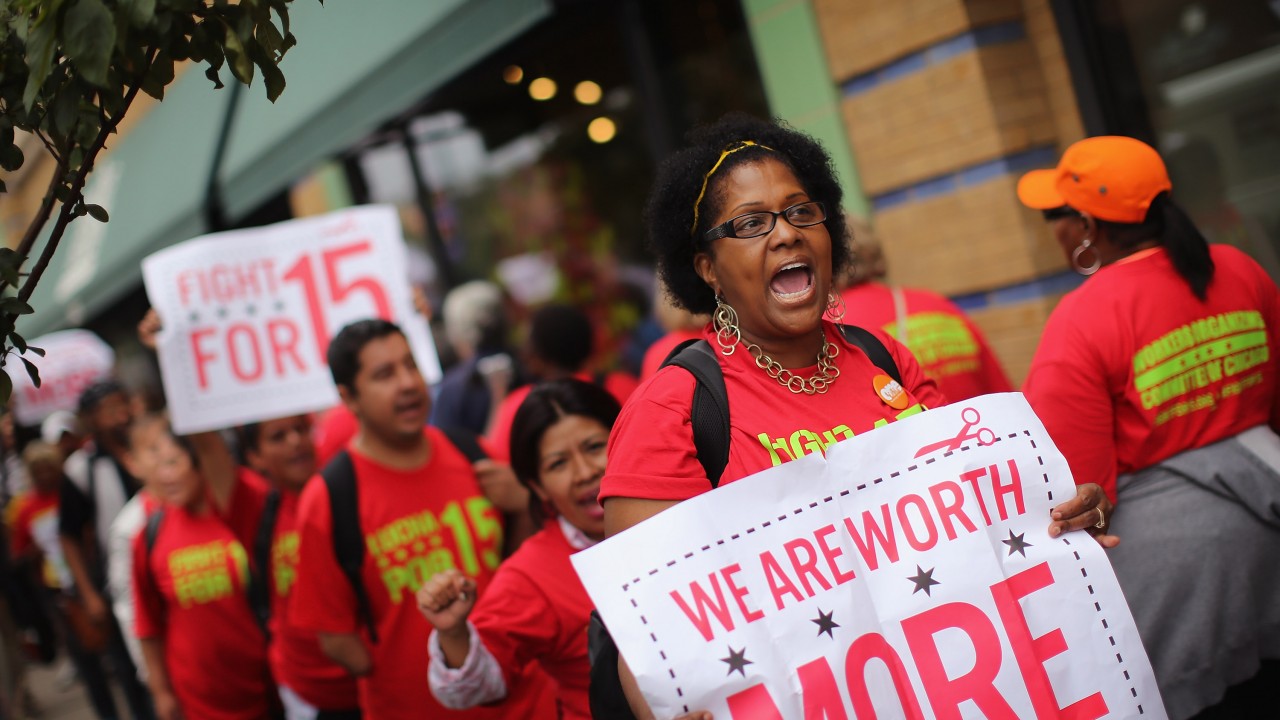
Whole Foods Market employees and union activists protest outside a Whole Foods Market store in July 2013 in Chicago, Illinois. The protest was one of many scheduled against fast food and retail stores in several cities nationwide. (Photo by Scott Olson/Getty Images)
This post originally appeared at TalkPoverty.
The 2016 presidential race is revving up, the Supreme Court and National Labor Relations Board are weighing union and workers’ rights cases and questions of tax reform, living wages and the right to unionize are hotter than they’ve been in generations. It may feel to some as though all the current talk of economic inequality came over us rather suddenly. But, of course, the current focus on inequality did not come out of nowhere. And its popularity today — among the young (who suffer from wildly disproportionate unemployment rates) and the poor (whose share of American annual income continues to fall) — should not surprise anyone who has been paying attention.
If Americans are talking about poverty again with greater urgency than they have since the 1970s, it is because they are rightly angered by the cruelties of the 21st-century economy. Wages have been stagnant for decades, steadily eroding what people can afford. Fewer and fewer jobs offer benefits. Even the success stories — young people who graduate from college — carry crushing levels of student debt that prevents them from purchasing homes or cars. Staggering health care costs have driven millions of American families into bankruptcy. And tens of millions of workers, even those in professional occupations, have become “contingent labor” with no job security. Their hours are changed whenever it suits management.
This new economy has fueled massive protest both here and abroad. And sustained organizing by millions of low-wage workers, students, immigrants and the homeless has reframed the issue of American poverty in ways that are reminiscent of the 1930s. Poverty, these activists argue, is an issue of fairness to workers and to the middle class — it’s caused by corporate greed more than anything else.
Without question, the global crash of 2008 contributed to the change in thinking about growing economic inequality in the US and abroad. But it was not the crash alone that caused this change. Rather, it has been a dramatic upsurge over the past five years of grassroots organizing and protest. Without those, concern about poverty had little staying power in American politics between the 1970s and the present. Poverty was briefly rediscovered as an issue after Hurricane Katrina devastated New Orleans in 2005. A then-little-known senator named Barack Obama pronounced it a shame “that it has taken a crisis like this one to awaken us to the great divide that continues to fester in our midst.” But, if Americans were indeed ashamed, we were not ashamed for long. The year after the hurricane struck, President George W. Bush proposed zeroing out funding for the Community Development Block Grant program, which is used for affordable housing, infrastructure, job creation and many other local antipoverty programs.
Bush’s proposal was defeated, but the language and iconography used to stir up opposition to federal poverty programs after Katrina was deeply familiar to any student of 20th-century American politics. It came down to a simple formula: blame women of color, especially single mothers. Columnist George Will argued that poverty could be defeated only if poor women stayed in school and did not have babies out of wedlock. And George W. Bush created the Healthy Marriage Initiative (HMI), which siphoned off federal anti-poverty funds to private marriage counseling programs for poor women. Although the US Department of Health and Human Services called for voluntary participation in these programs, women I interviewed in Reno said they were required to attend HMI sessions if they were enrolled in the Temporary Assistance for Needy Families (TANF) income assistance program.
The discourse about poverty in the US did not really begin to shift away from that tired trope until around 2011 and 2012, when students, the unemployed and the homeless began to move into Occupy Wall Street encampments from New York to California. Despite being mocked and excoriated by mainstream media for having “no clear goals,” these activists focused national attention away from the so-called “moral flaws” of the poor to the most important sources of 21st-century American poverty: predatory lending, immorally expensive medical bills that were causing people to lose their homes and wages that were insufficient to pay people’s bills.
Occupy introduced into American political discourse a simple, effective image of the American economy, juxtaposing most of “us” — the 99 percent — against the 1 percent, to which a staggering proportion of national wealth had been flowing since the Reagan Revolution began in 1980. The reason was clear: since the late 1970s, top marginal tax rates had been cut from 70 percent to little more than 30 percent, redirecting almost all American wealth to the top 1 percent of earners. This image took hold, and did as much to raise consciousness about economic inequality as twenty densely argued economics texts. But it also prompted a spate of more closely reasoned economic arguments about economic inequality — most famously from Thomas Piketty, Paul Krugman, Joseph Stiglitz and Robert Reich.
Suddenly poverty in America began to look different, and many average Americans began talking about it differently too. Maybe it wasn’t poor people’s fault after all. Recovery from the 2008 recession did create millions of new jobs but 58 percent of them did not pay enough to keep a full-time worker clothed, housed and fed. By 2011, the results were crystal clear: college graduates were defaulting on student loans by the millions; full-time workers were living in homeless shelters or sleeping on relatives’ couches.
When police were called in to break up Occupy encampments, the movement was declared over — another flash in the pan. But that’s not what happened. Organizers shifted gears, unions invested resources, and the banner of economic justice was picked up by low-wage workers.
The movement for a living wage got its start with small protests by Walmart workers across the country. The first came on Black Friday 2012, the biggest shopping day of the year. Outside Walmart stores, McDonald’s restaurants and other fast food chains, workers let the world know that 52 percent of them were forced to rely on government cash and food aid to supplement their meager paychecks. These small protests in New York, Chicago and the working-class LA suburb of Pico Rivera would soon spread across the US and around the world.
Workers captured and broadcasted video and still images on social media, no longer dependent on corporate media. Unlike the long, grinding strikes of the 20th century, flash strikes could be and were repeated again and again. Every few months there were more.
In May 2014, fast food workers walked off the job in 190 US cities, and in 33 other countries, on six continents. In November 2014, Walmart workers held the first retail sit-down strikes since the 1930s, carrying photographs of Depression-era Woolworth sit-down strikers. In April 2015 and again in December, low-wage workers in fast food, home health care, airports and chain retail stores struck in 500 American cities; hotel housekeepers staged actions from Providence, Rhode Island to Long Beach, California and from Karachi, Pakistan to Abuja, Nigeria. All of these groups of workers are continuing to organize and — as a result — public opinion about raising wages has become ever-more positive.
Low-wage strikes have highlighted the fact that the prime welfare cheat, it turns out, is not Ronald Reagan’s fictitious Cadillac-driving, African-American single mother, but the world’s wealthiest corporations. Unwilling to pay their workers a living wage, they use federal poverty programs to subsidize their labor costs. The majority of low-wage workers, and the majority of living wage protesters, are in fact single mothers of color, and the next largest group are men of color. Who is cheating whom, the protesters ask? The answer is clear.
Since 2012, the campaign for a $15 living wage has had more success than anyone imagined it would. Los Angeles City and County, Seattle, San Francisco and many other cities and states have passed increases to the minimum wage and adopted the idea of a living wage. In the 2016 presidential campaign, we are once again discussing the ideas of universal health care as a right in the United States, federally-subsidized day care, free public universities, and progressive tax reform. And millions of protesters are taking us back in time to rehash debates that raged in the eras of Franklin Roosevelt, Harry Truman and Lyndon Johnson.
Welcome to the new War on Poverty.




